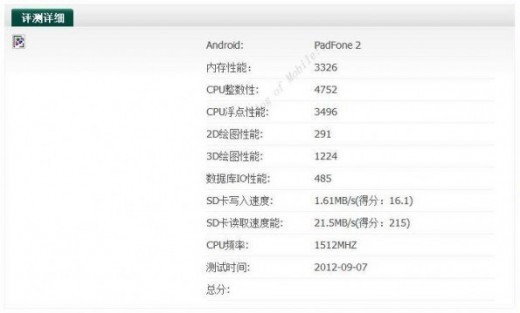AnTuTu Benchmark Database Reveal Quad-Core CPU for Asus PadFone 2
Database reveals that device could come with a quad-core Snapdragon S4 Pro processor

The unannounced Asus PadFone 2 has made its appearance in an AnTuTu benchmark database. The Tablet News reports that the leak shows up the device's name PadFone 2 and is expected to run the Android 4.0.4 (Ice Cream Sandwich) operating system. The followup to the original PadFone, the Padfone 2 could come with CPU operating frequency at 1512MHz, according to the benchmark database.
The device could come with a quad-core Snapdragon S4 Pro processor. It is expected to ship 2GB of RAM. As of now, there is no word as to when the second edition of PadFone will be unveiled, while it is speculated to be introduced at CES in January.
The leak reveals that the device could run ICS, while there is a possibility that it could show Android 4.1 (Jelly Bean) on board. Reports suggest that the device's price and design are still under wraps.
"They should make the device a bit thinner, give the phone more battery and make the bulk at the back smaller, the one where the phone is housed," claims Tablet News.
In May, the PadFone 2 had made its appearance via leaked slides, even before the release of the original PadFone. The leaked slide showed up the device could sport an innovative 3-in-1 design featuring 4G capabilities.
Asus unveiled its PadFone at the Mobile World Congress (MWC) 2012. It sports an optional PadFone station featuring a 10.1in display with a resolution of 1,280 x 800 pixels. The PadFone comes with internal storage of 16/32/64GB and a microSD card slot with an additional memory space up to 32GB.
Unlike the processor of PadFone 2, the PadFone is powered by a dual-core 1.5GHz Krait processor. The device is powered by a Qualcomm MSM8260A Snapdragon chipset. In terms of speed, it provides support to HSDPA 21Mbps and HSUPA 5.76Mbps. It features Wi-Fi 802.11 b/g/n and Wi-Fi hotspot. It offers support to Bluetooth with A2DP technology. It packs Li-Ion 1520mAh standard battery that gives a standby time of up to 360 hours on 2G and 370 hours on 3G networks. It provides talktime of up to 15 hours 40 minutes on 2G and eight hours on 3G networks.
© Copyright IBTimes 2025. All rights reserved.





















